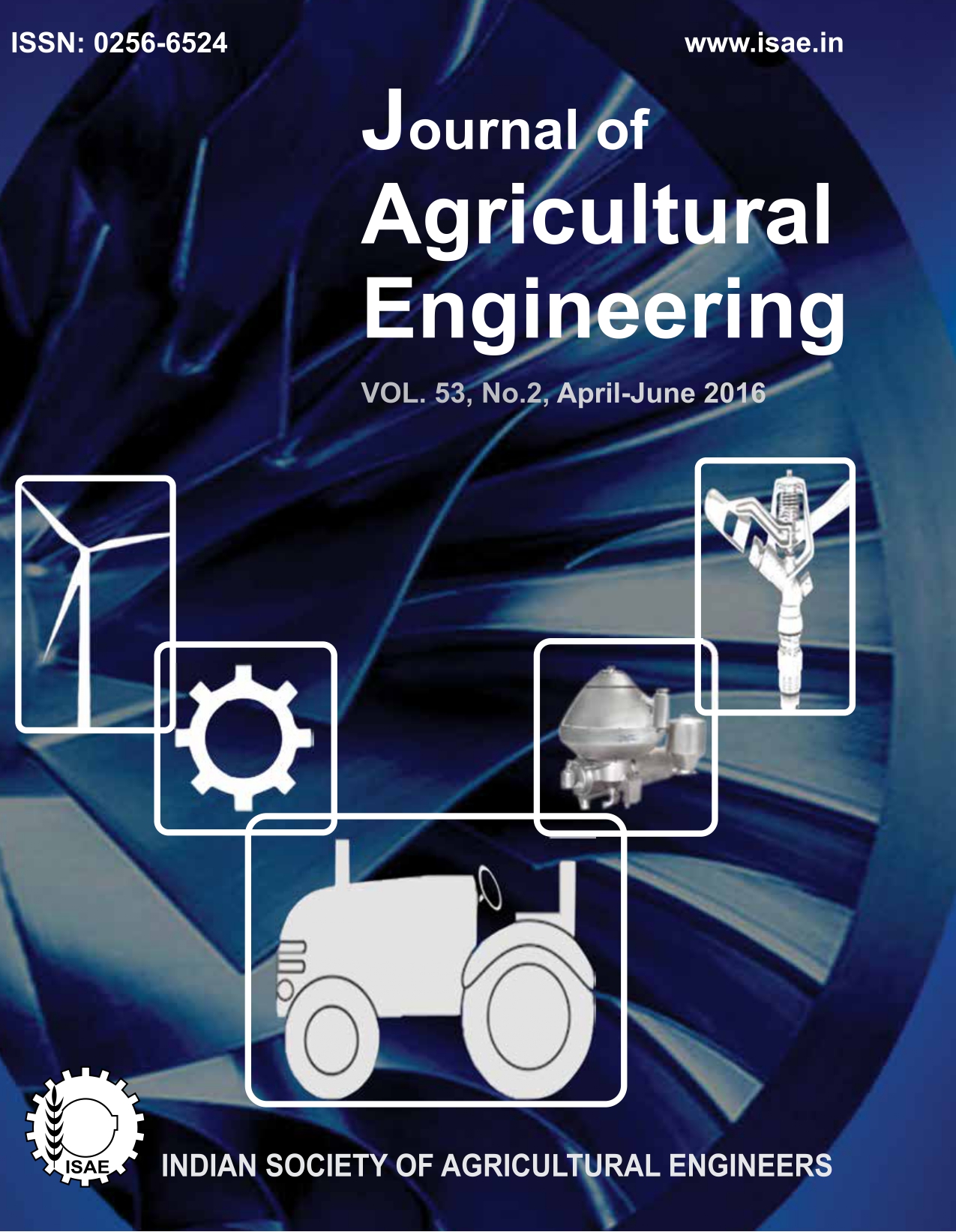Development of Crop Water Demand Based Water Delivery Schedule for a Canal Command
DOI:
https://doi.org/10.52151/jae2016532.1599Keywords:
GIS, CROPWAT, irrigation scheduling, rice, wheat, canal irrigationAbstract
Crop water demand-based canal water delivery schedule was developed using geospatial tools and CROPWAT model for the Jhajjar distributary of Western Yamuna Canal Command in Haryana, India. The geospatial database of different soil, water and crop parameters in the command area were developed and analyzed using the Geographic Information System (GIS) tool. Further, the geospatial data were used to work out the irrigation schedule of different crops using CROPWAT model. It was observed from the analysis that the gross irrigation water requirement of wheat was 363.4 mm and that of rice was 1386 mm with effective rainfall depths of 55.8 and 461.8 mm during the wheat (rabi) and rice (kharif) growing seasons, respectively. The crop water demand driven protocol developed in this study estimated that about 25.5% of area under the Jhajjar distributary could be supplied with adequate irrigation, considering the operational canal release roster of the distributary. Nontheless, it could be recommended to modify the existing roster as per the crop water demand estimates, or use of ground water resource in area of deficit canal supply to match the crop water demand in the entire canal command.
References
Ackermann R. 2012. New directions for water management in Indian agriculture. Global J. Emergy Market Econ., 4, 227-228.
Al-Nazer H. 2011. The integration of FAO CROPWAT model and GIS techniques for estimating irrigation water requirement and its application in the Gaza strip. Nat. Resour., 2, 146-154.
Anon. 2010. FAO Agristat Database. http://www.indiastat.com/table/agriculture/2/irrigationbysource19951996to20082009/449345/10539/data.aspx (last accessed on 6th August 2015).
Anon. 2011. Canal roster and capacity statement of Jhajjar distributary. Jhajjar Water Services Division, Jhajjar, India, pp. 20.
Dash J. 2011. Modelling nitrate pollution of groundwater at IARI farm. Unpublished Ph.D. thesis, IARI, New Delhi.
Erdas Imagine. 2010. Erdas Imagine software. Erdas, Inc., Atlanta, Georgia, USA. http://www.hexagongeospatial.com/products/producer-suite/erdasimagine.
ESRI. 2011. ArcGIS Desktop: Release 10. Environmental System Research Institute, Redlands, USA. http://www.arcgis.com/features (Last accessed on 1st April 2016).
Fortes P S; Platonov A E; Pereira L S. 2005.GISAREG - A GIS based irrigation scheduling simulation model to support improved water use. Agric. Water Manage., 77, 159-179.
George B A; Raghuwanshi N S; Singh R. 2004. Development and testing of a GIS integrated irrigation scheduling model. Agric. Water Manage., 66, 221-237.
Jurriens M; Mollinga P; Wester P. 1996. Scarcity by design: Protective irrigation in India and Pakistan. ICID J., 45(2), 31-53.
Kuo S; Ho S; Liu W. 2006. Estimation irrigation water requirements with derived crop coefficients for upland and paddy crops in Chia Nan Irrigation Association, Taiwan. Agric. Water Manage., 82, 433–451.
Pakhale G; Gupta P; Nale J. 2010. Crop and irrigation water requirement estimation by remote sensing and GIS: A case study of Karnal District, Haryana, India. Int. J. Eng. Technol., 2, 207-211.
Raidu C R; Giridhar M V S S. 2011. Geo-spatial database creation for Wazirabad canal command area. J. Geog. Inf. Syst., 3, 290-297.
Rao B K; Rajput T B S. 2009. Decision support system for efficient water management in canal command areas. Current Sci., 97, 90-98.
Rao N H; Brownee S M; Sharma P B S. 2004. GIS based decision support system for real time water demand estimation in canal irrigation systems. Current Sci., 87, 628-636.
Ray S S; Dhawal V K. 2001. Estimation of crop evapotranspiration of irrigation command area using remote sensing and GIS. Agric. Water Manage., 49, 239–249.
Rowshon M K; Kwok C Y; Lee T S. 2003. GIS-based scheduling and monitoring of irrigation delivery for rice irrigation system. Agric. Water Manage., 62, 105–116.
Salmah Z; Aminuddin Y; Marzuki H; Azizah J. 1994. Research requirements in agricultural drainage of Malaysia. In: Proc. 7th ICID International Drainage Workshop, Penang, Malaysia, 3,10-14.
Santhi C; Pundarikanthan N V. 2000. A new planning model for canal scheduling of rotational irrigation. Agric. Water Manage., 43, 327–343.
Shah A. 2003. Tail-Enders and other deprived in canal irrigation systems: Gujarat. National Workshop on Tail-Enders and Other Deprived in Canal Irrigation Systems, Ahmedabad, India.
Singh A; Krause P; Panda S N; Flugel W. 2010. Rising water table: A threat to sustainable agriculture in an irrigated semi-arid region of Haryana, India. Agric. Water Manage., 97, 1443–1451.
Smith M. 2006. CROPWAT, a computer program for irrigation planning and management. FAO Irrigation and Drainage Paper No. 46, Rome, pp:133.
Tyagi N K; Sharma D K; Luthrea S K. 2010. Determination of evapotranspiration and crop coefficients of rice and sunflower with lysimeter. Agric. Water Manage., 45, 41–54.
Yarahamdi J. 2003. The integration of satellite images, GIS and CROPWAT model to investigation of water balance in irrigated area: A case study of Salmas and Tassoj plain, Iran. Unpublished M.Sc. Thesis, International Institute for Geo-information Science and Earth Observation, Enschede, The Netherlands.














